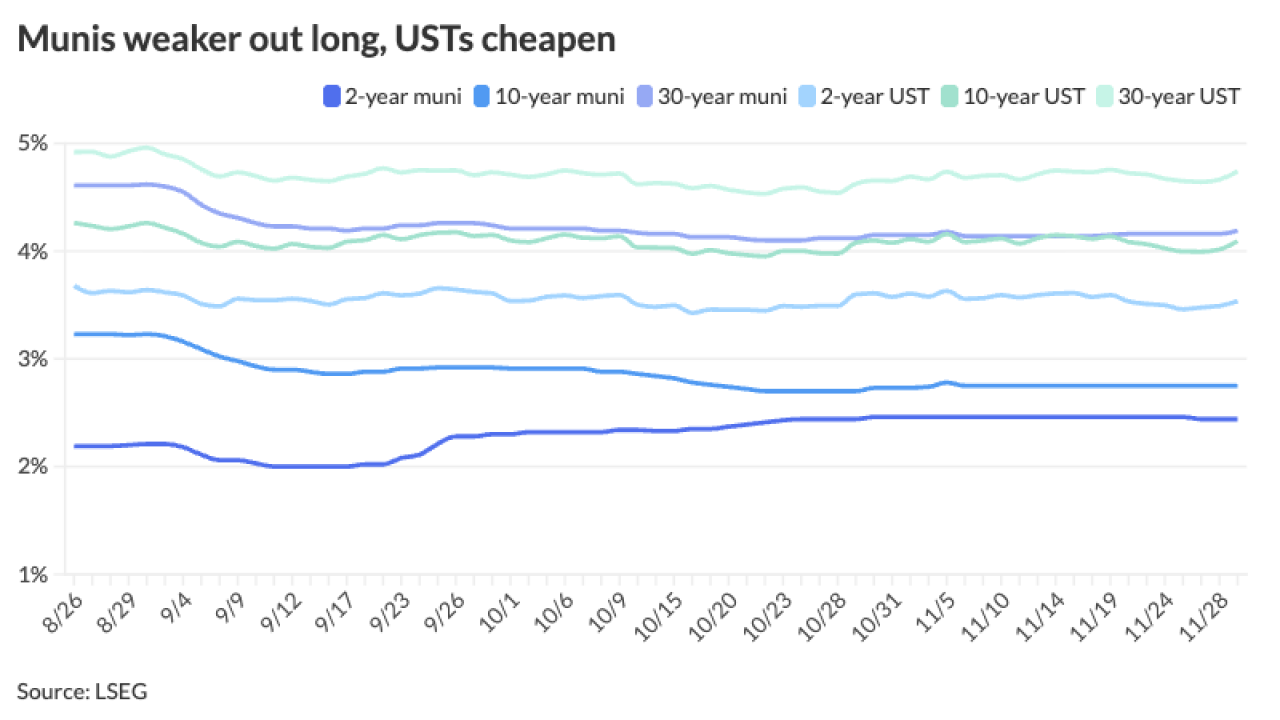Hurricane Ida delivered a heavy blow to health systems already battling the fourth wave of a pandemic.
Louisiana utilities face a long, costly path to full restoration of power as the oil industry seeks to resume operations. Labor shortages could hamper reconstruction efforts and raise costs.
But long-term damage to municipal credits in the hurricane’s path is not likely, according to early reports from analysts.

Insurance industry analysts are expecting Ida’s recovery costs to be about $10 billion, a tenth of the costs of Hurricane Katrina, which hit the same area in 2005.
“Economic growth could fall slightly in the third quarter but this is likely to quickly rebound as federal aid is delivered to the state and local government hit by the storm,” said Tom Kozlik, head of municipal research and analytics at Hilltop Securities.
“Hurricane Ida is not likely to impair the credit quality of most state, local, and other municipal entities,” he wrote in a market commentary Monday.
“State government credit quality is unlikely to be affected,” he added. “A small number of local governments and hospitals may have a more difficult time managing the recovery path, but this should reverse once Federal Emergency Management Agency funds begin flowing and insurance reimbursement occurs.”
Arriving 16 years to the day after the crippling Hurricane Katrina, Ida tied with the Last Island Hurricane in 1856 and Hurricane Laura in 2020 for the strongest maximum sustained winds for a Louisiana landfall, according to Phil Klotzbach, a research scientist with Colorado State University’s Tropical Meteorology Project.
Fitch Ratings cited estimates of $15 billion to $25 billion in losses, which would fall below the record $65 billion in insured losses from Katrina.
Ida will likely surpass winter storm Uri as the largest industry event in 2021. Uri, which hit Texas and surrounding states the week of Feb. 15, bringing bone-chilling cold and taking much of the Texas electric grid offline, caused about $15 billion in insured losses.
“While losses will take some time to reconcile, there are indications that this will be an earnings and not capital event for the industry,” Fitch said.
Ida is expected to generate “significant economic and insured losses in Louisiana” but probably will not cause ratings downgrades of insurers or reinsurers, Fitch said.
Moody’s Investors Service expects it to take months to assess the Ida’s impact on the property/casualty industry.
The top 10 insurers in Louisiana write a total of $744 million in direct premiums, and the industry total premiums for the state are $1.735 billion, according to Moody’s.
William Liebler, U.S. chief claims officer at Marsh LLC, said that solid estimates of damage are still to come. When Hurricane Harvey hit the Texas coast in 2017, the costs continued to mount each month.
Further damage is expected in Mississippi, Alabama and other inland states as heavy rains and gusty winds from Ida or its remnants move into the Tennessee Valley and Mid-Atlantic.
Morgan Stanley credited the $15 billion upgrade to the
Louisiana Citizens Property Insurance Corp., which covers state residents and small businesses unable to buy property insurance through the voluntary market, provides a level of support, Moody’s said. The agency has $545 million in total reinsurance and catastrophe bonds in place to pay storm losses.
One hospital generator failed during Ida, but most others continued operating after major power transmission lines were toppled.
Dr. Jeff Elder, medical director for emergency management at LCMC Health, which operates hospitals in New Orleans, said hospitals discharge patients who are able to leave before a storm hits. However, the pandemic limited that effort.
“We’ve learned a lot since 2005,” Elder told ABC News.
After Katrina, critical infrastructure such as generators were elevated above likely flood levels. At University Medical Center in New Orleans, which was built after Katrina, the generator is raised, diesel supplies are protected and the first floor doesn’t have essential services so even if flood waters get that high nothing essential is lost.
Hospitals and their intensive care units were filled with patients from the fourth surge of the COVID-19 pandemic, sparked by the Delta variant and low vaccination rates across Louisiana.
Louisiana Gov. John Bel Edwards said that
Edwards also said 22 nursing homes and 18 assisted living facilities have been evacuated, though evacuating the largest hospitals was not an option because there simply weren’t other places to send them.
Those in the hardest-hit areas could experience power outages for weeks, according to the Entergy, the investor-owned utility that serves many of the hard-hit areas.
As of Monday, Entergy had 888,229 power outages in Louisiana due to Ida’s destruction. Power outages continued to increase as the storm moved through Mississippi.
“We know of one transmission line that spans the Mississippi River that is down,” the company said. “The destroyed tower withstood Hurricane Katrina that struck the area in 2005.”
The Electricity Subsector Coordinating Council, the main liaison between the federal government and the electric power industry on disasters, said the grid serving Louisiana and Mississippi suffered heavy damage.
“Entities impacted by Hurricane Ida — including investor-owned electric companies, electric cooperatives, and public power utilities — and their mutual assistance partners are committed to restoring power safely and as quickly as possible,” the agency said.





